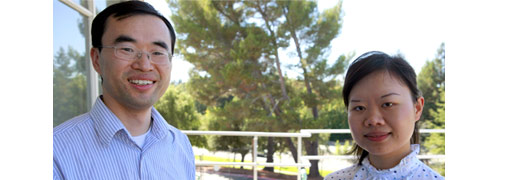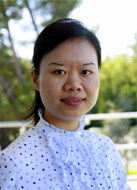Intern Profile – Lulu He

Senior researcher Feng Tang and intern Lulu He.
This is a series of profiles featuring interviews with some of this year's crop of summer interns at HP Labs.
We continue the series with an interview with Lulu He who was recruited by the Printing and Content Delivery Lab.

Intern Lulu He
Lulu He grew up in Wuhan, in central China. “It’s a really big city, like Chicago,” He says of her home town. “All the airlines meet there.” He stayed in Wuhan for both her bachelors and masters degrees, studying electrical engineering at Huazhong University of Science and Technology. She then moved to Northwestern University where she’s a fourth year PhD student in electrical engineering and computer science and where she enjoys running, music and watching movies in her spare time. This is He’s first internship at HP Labs.
HP: What are you working on this summer?
I’m working with Dan Tretter and Feng Tang in the Printing and Content Delivery Lab and my project is looking at human segmentation in consumer photos. Essentially, I’m trying to separate human subjects from their backgrounds using computer vision techniques and image processing. What’s different about the project is that I’m trying to extract the contour of the whole human body in any position, rather than just the face, for example, or just people who are walking. It means I have far fewer constraints on what I’m detecting as people can adopt all kinds of wild poses. I’m also doing this with consumer rather than professional images, which means the backgrounds can vary hugely.
HP: That’s really ambitious! What have you managed to achieve so far?
It is quite challenging. So far, I’ve been working on images of soccer players. I first collected a bunch of images of players in all kinds of poses and I’ve managed to segment out the players’ bodies in the images. With soccer players the background and their uniforms are relatively contrasting and coherent. That helps a lot. Next I want to be able to handle more complex backgrounds that contrast less with the players’ clothes and then I want to tackle the problem of wild poses where the players are leaping or lying down, for example.
HP: What technologies are you using here?
I’m designing algorithms that teach the computer how to ‘see’ and recognize patterns. Basically, it’s using machine learning techniques.
HP: What implications might this research have?
If we solve this problem, the technique can be used in lots of cool applications. Automatically generating an accurate outline of people’s bodies would, for example, allow us to create better photo editing software – where you could sharpen the focus on a person and soften the background – or make more convincing and professional-looking collages and montages.
HP: How is your work at HP Labs relating to your graduate work?
This project is closely related to the work that I’m doing at Northwestern. That’s also about image segmentation but looks at segmentation at a more fundamental level. There, given an image, I’m looking to identify multiple segments within an image that have a coherent color, intensity or texture.
HP: You’ve had internships at other industrial labs before. What’s stood out for you about interning at HP?
I’ve really enjoyed the activities that have been organized for the interns. They’ve allowed me to meet a lot of interesting people, both among the interns and the researchers. I’ve been able to get a lot of very good feedback from them about my project and I’ve been able to learn a lot about the other research that’s going on here. Overall, the research atmosphere is very flexible. You have a lot of freedom and you’re in an environment that’s very constructive – and inspiring, too.